Lease Agreements
In commercial real estate, there are several types of lease agreements that landlords can make with tenants. When looking for commercial real estate, it is imperative that tenants understand the terms and structure of the lease agreement. In a net lease, the basic structure usually consists of a base rent amount plus additional costs for typical operational expenses. Typical operational expenses can include property insurance, real estate taxes, maintenance costs, and other expenses. Net leases primarily differ from gross lease in how the rent amount is determined every month. Net lease rent amounts are comprised of multiple costs and expenses that can vary month to month or annually while gross lease agreements call for a single monthly payment of a fixed amount.
Absolute Net Lease vs. Triple Net Lease
Absolute net leases differ from triple net leases and other net leases because in this agreement, the tenant is required to a pay a base rent amount plus all expenses associated with the operational, maintenance, and repair of the facility. In this agreement, tenants experience the highest amount of responsibility for the space because they are responsible for all costs. In this scenario, the tenant is responsible for all financial risks that could arise from use of the space.
Review Proposals
As a tenant, when reviewing lease proposals for commercial real estate, you should overview your lease agreement in detail before making the agreement. There are instances where a lease is advertised as a triple net lease, where tenant is responsible for some operational expenses, but upon reviewing of the terms, the agreement is more like an absolute net lease where tenant is responsible for all ownership expenses of the property. While the difference between triple net and absolute net leases may seem slight, they aren’t. An absolute net lease is an entirely different beast.
For more info contact Casandra Properties at 718.816.7799 or email info@CasandraProperties.com







Leave a Comment